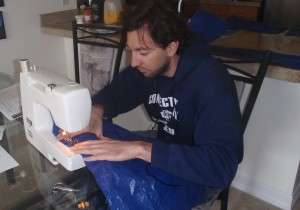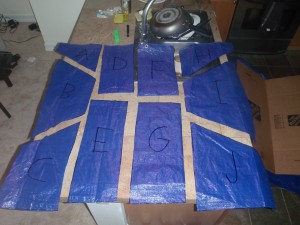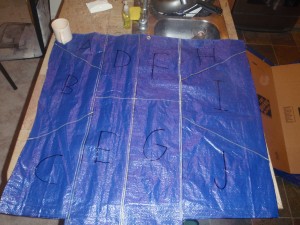Apr 27 2009
Fortuitous Encounters
In the midst of boat work we frequently acknowledge the “right tool for the job”; tonight it was all about the “right person at the right time”.
I had a frustrating day trying–and failing–to drill a few holes in a piece of stainless steel. Drilling a few holes was my ONLY goal for the day–it has to be done before I can move forward with my current project–but after driving a hundred miles, stopping at various specialized establishments, spending an emotionally debilitating amount of money, and carrying multiple heavy metal objects back and forth multiple times, this task went unfulfilled. Along the way I did some other errands fine but Damn! I really just wanted to get those holes drilled!
One would think that drilling holes is not that difficult. But sometimes Oh hell yes it is. In the past month I have learned how to TIG weld, use a mill and a lathe, how to adjust and replace blades on a serious band saw, how to properly cope a piece of tubing to mate to another piece of tubing, and designed and insulated an icebox. I assure you! drilling large holes in thick stainless steel remains the MOST IMPOSSIBLE TASK of everything we have done on the boat so far. Seriously, harder than everything else. Why? This amateur can offer only justifications (since I haven’t found the answer). Stainless is much harder than “mild” steel. If your drill bit doesn’t cut into it, dig into it properly, than all of the energy of spinning that bit goes into friction–thus heat–and when you heat stainless steel it only gets HARDER than it already is. I tell you truly: a quarter-inch thick slab of stainless steel is where drill bits go to die. You can drill all you want, you can press as hard as you can–with a drill press–you can pour cutting fluid on it, you can use exactly the right speed, you can buy expensive cobalt bits, but at the end of the day you’ll end up with a pile of dull drill bits and a piece of metal with a partial hole in it. And all of your efforts will have served only to harden the metal via that excess heat. It’s a downward spiral leading to frustration and despair and wasted money and broken drill bits, and yes I will shamefully admit that my failure to drill holes in stainless steel ruined my day today, has ruined many of our days in the past, and will probably ruin plenty more. What a silly thing to ruin a day! It’s only metal and a hole! But when there’s no one who can do it for you, and you can’t get it done, and you absolutely need to . . .
After returning home with an attitude of failure inadequacy and disgust, I chose to pursue a proper drink at the Trappist in Oakland (best source of real beer–i.e. Belgian–in the entire east bay) with Karen. At the Trappist, we happened to sit next to a guy who happened to be wearing his California Blacksmithing Society t-shirt and happened to have work-blackened hands which I happened to notice and on which I chose to comment. His name is Brad Faris, and had I tried I could not have found a more ideal individual to answer all my metalworking questions and ease the specific frustrations of my day. Brad’s father was a pinball machine artist, and Brad was originally a pinball machine designer, who became a blacksmith after moving to germany to build pinball machines, and is now a custom smith with a studio in Oakland. Hell of a story, hell of a nice guy. Brad is a stellar individual with a wealth of knowledge, and it was a pleasure to talk to him.
Brad and Karen and I talked technical stuff, like the reason why brass goes pink when it goes bad (the zinc in the alloy is oxidized, leaving on the copper, and porously weak) and what naval bronze does when welded (spitting zinc and producing salt-like deposits) versus silicon bronze (beautiful puttied welds), but we also talked about pinball machines and neat hot forges and old school metal suppliers in petaluma, which is to say that we weren’t dorking out at all–it was interesting and accessible and it was a conversation in a bar while buzzed that was filled with content and value and excitement to me and Karen both. He gave me the important names of the metal and tool supply places that I needed to know immediately, like KBC tools where tomorrow morning I’m going to get some new sharp drill bits and “TAP magic” cutting fluid for tomorrow’s second attack on the stainless. And US Metals which is a more standard supplier than ALCO metals which is like a metal flea market by analogy, and Metal Supermarket which is good for small pieces because they have smaller stock on hand and are more willing to cut and sell it in small quantities, and Van-Bebber in Petaluma which–even though it’s in a silly location for a place that gets all its raw materials from shipping yards in the bay–is apparently the type of customer-service rich operation that draws people from all over to make the inconvenient drive for a great product. Brad knows his shit! So incredibly fortuitous that we just happened to run into him at a bar on the day that I most needed his particular expertise.
There is an oft repeated saying on the boat, about having the “right tool for the job”. For the water tanks, it was the cutoff blade (yeah the cutoff blade is frequently that “right tool”) on a 4″ grinder, for the icebox insulation it was Japanese pull saw, for rebedding it’s 4200 UV fast cure, the list goes on and on. Tonight I have to say that Brad Faris was the right person at the right time. His expertise is exactly what I needed to know to turn today’s frustrations into an optimism for a different tomorrow. I’m excited about tomorrow because I have new ideas about how to properly succeed with that piece of stainless–tomorrow I’m going to do everything right and at the end of the day I’m going to finally be able to give a detailed technical dissertation on how to kick 304 stainless ass. Hell of a frustrating day, hell of a rewarding night.




